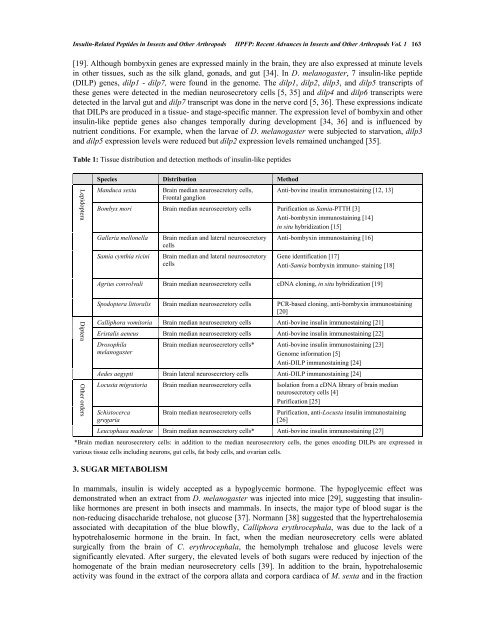chapter 1 - Bentham Science
chapter 1 - Bentham Science
chapter 1 - Bentham Science
Create successful ePaper yourself
Turn your PDF publications into a flip-book with our unique Google optimized e-Paper software.
Insulin-Related Peptides in Insects and Other Arthropods HPFP: Recent Advances in Insects and Other Arthropods Vol. 1 163<br />
[19]. Although bombyxin genes are expressed mainly in the brain, they are also expressed at minute levels<br />
in other tissues, such as the silk gland, gonads, and gut [34]. In D. melanogaster, 7 insulin-like peptide<br />
(DILP) genes, dilp1 - dilp7, were found in the genome. The dilp1, dilp2, dilp3, and dilp5 transcripts of<br />
these genes were detected in the median neurosecretory cells [5, 35] and dilp4 and dilp6 transcripts were<br />
detected in the larval gut and dilp7 transcript was done in the nerve cord [5, 36]. These expressions indicate<br />
that DILPs are produced in a tissue- and stage-specific manner. The expression level of bombyxin and other<br />
insulin-like peptide genes also changes temporally during development [34, 36] and is influenced by<br />
nutrient conditions. For example, when the larvae of D. melanogaster were subjected to starvation, dilp3<br />
and dilp5 expression levels were reduced but dilp2 expression levels remained unchanged [35].<br />
Table 1: Tissue distribution and detection methods of insulin-like peptides<br />
Lepidoptera<br />
Diptera<br />
Other orders<br />
Species Distribution Method<br />
Manduca sexta Brain median neurosecretory cells,<br />
Frontal ganglion<br />
Anti-bovine insulin immunostaining [12, 13]<br />
Bombyx mori Brain median neurosecretory cells Purification as Samia-PTTH [3]<br />
Anti-bombyxin immunostaining [14]<br />
in situ hybridization [15]<br />
Galleria mellonella Brain median and lateral neurosecretory<br />
cells<br />
Samia cynthia ricini Brain median and lateral neurosecretory<br />
cells<br />
Anti-bombyxin immunostaining [16]<br />
Gene identification [17]<br />
Anti-Samia bombyxin immuno- staining [18]<br />
Agrius convolvuli Brain median neurosecretory cells cDNA cloning, in situ hybridization [19]<br />
Spodoptera littoralis Brain median neurosecretory cells PCR-based cloning, anti-bombyxin immunostaining<br />
[20]<br />
Calliphora vomitoria Brain median neurosecretory cells Anti-bovine insulin immunostaining [21]<br />
Eristalis aeneus Brain median neurosecretory cells Anti-bovine insulin immunostaining [22]<br />
Drosophila<br />
melanogaster<br />
Brain median neurosecretory cells* Anti-bovine insulin immunostaining [23]<br />
Genome information [5]<br />
Anti-DILP immunostaining [24]<br />
Aedes aegypti Brain lateral neurosecretory cells Anti-DILP immunostaining [24]<br />
Locusta migratoria Brain median neurosecretory cells Isolation from a cDNA library of brain median<br />
neurosecretory cells [4]<br />
Purification [25]<br />
Schistocerca<br />
gregaria<br />
Brain median neurosecretory cells Purification, anti-Locusta insulin immunostaining<br />
[26]<br />
Leucophaea maderae Brain median neurosecretory cells* Anti-bovine insulin immunostaining [27]<br />
*Brain median neurosecretory cells: in addition to the median neurosecretory cells, the genes encoding DILPs are expressed in<br />
various tissue cells including neurons, gut cells, fat body cells, and ovarian cells.<br />
3. SUGAR METABOLISM<br />
In mammals, insulin is widely accepted as a hypoglycemic hormone. The hypoglycemic effect was<br />
demonstrated when an extract from D. melanogaster was injected into mice [29], suggesting that insulinlike<br />
hormones are present in both insects and mammals. In insects, the major type of blood sugar is the<br />
non-reducing disaccharide trehalose, not glucose [37]. Normann [38] suggested that the hypertrehalosemia<br />
associated with decapitation of the blue blowfly, Calliphora erythrocephala, was due to the lack of a<br />
hypotrehalosemic hormone in the brain. In fact, when the median neurosecretory cells were ablated<br />
surgically from the brain of C. erythrocephala, the hemolymph trehalose and glucose levels were<br />
significantly elevated. After surgery, the elevated levels of both sugars were reduced by injection of the<br />
homogenate of the brain median neurosecretory cells [39]. In addition to the brain, hypotrehalosemic<br />
activity was found in the extract of the corpora allata and corpora cardiaca of M. sexta and in the fraction

















